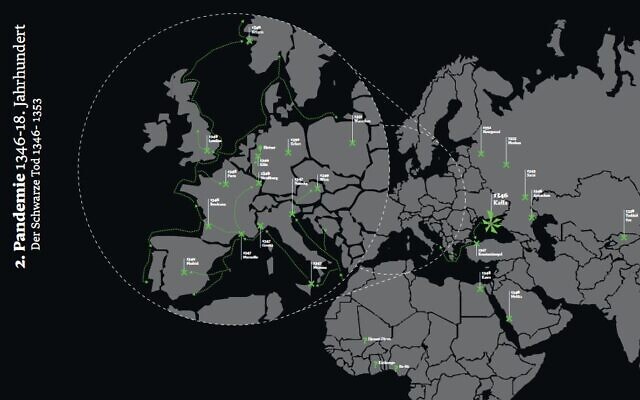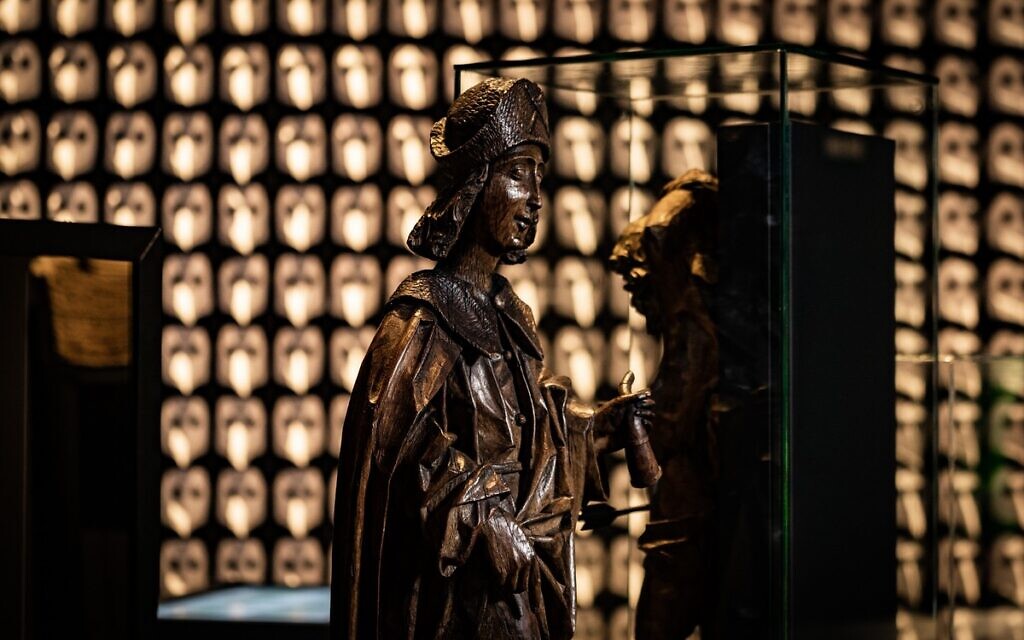After the COVID-19 outbreak, a museum suddenly finds itself in the spotlight as its now-online display on the religious and medical reactions to medieval plagues spikes in demand.
BERLIN — When the exhibition “Plague!” opened at the Museum of Archeology in the west German city of Herne last September, interest was largely limited to local audiences and media. By mid-March, when Germany adopted the first measures to stop the spread of the coronavirus, the exhibition was making headlines nationwide.
“This is understandable because parallels can be drawn — although the plague is caused by bacteria and is therefore curable, unlike COVID-19, which is caused by a virus,” says the exhibit’s curator, Stefan Leenen. “Although interest in the exhibition has increased enormously, most [potential] visitors, and especially school classes, could not come at all because of restrictions on travel.”
Only a few hours after the interview with Leenen, the museum was closed. The new plague had triumphed over the old one. But now, a virtual tour of this highly interesting exhibition is online.
Via some 300 objects, “Plague” shows both the medical and the religious reactions to medieval plagues, especially the Black Death (or Great Bubonic Plague), which hit Europe in the 14th century. Doctors at the time believed that bad vapors or an unfavorable constellation of the stars were to blame for the mass extinction. Christians and the Catholic Church chalked it up to the wrath of God.
 Dr. Stefan Leenen, curator of ‘Plague!’ (Courtesy Museum of Archeology Herne)
Dr. Stefan Leenen, curator of ‘Plague!’ (Courtesy Museum of Archeology Herne)
To allay this divine anger the Church launched a campaign of forced repentance. It tried to avert the impending doom by organizing mass processions, which probably only helped spread the bacteria even more, or by the cultish promotion of saints.
“Emperors or city councils took a vow to build a church or a pillar if the plague would stop or if it shunned the locals,” says Leenen. “Such a famous pledge was made in the Bavarian village of Oberammergau: If the plague spares us, we will perform the Passion of Christ every 10 years.” Figure of St. Sebastian, who was believed to protect from the plague. (Courtesy Museum of Archeology Herne)
Figure of St. Sebastian, who was believed to protect from the plague. (Courtesy Museum of Archeology Herne)
That pledge was made in 1633 after 80 inhabitants had fallen victim to the plague. The first presentation took place a year later, and since then the villagers have kept their pledge, and the now-famous production runs on the first year of every decade, and involves a crew of 2,000 actors, musicians and technicians.
This year’s performances were slated to begin on May 16 and run until October 4. The village expected almost half a million passionate guests, but due to the coronavirus outbreak local authorities delayed the presentation until May 2022.
Just like the Spanish Flu in the 20th century, which infected 500 million people, the Black Plague was helped spread by soldiers. In 1346, an army of Tatars were laying siege to the Genoese port of Kaffa in the Crimea. The besiegers were infected by the plague and threw their dead into the city to cause it to surrender.
Through Genoese galleys the plague reached the Roman Empire and Europe, where it affected at first the coastal cities – Constantinople, Genoa and Venice. In 1348 it reached Paris, London and Cairo, before it spread to Madrid, Cologne and Vienna and later to Warsaw and Moscow. Within seven years the Black Death caused the death of 25 million people, a third of the European population.
Medieval Europeans knew well in advance that the plague was approaching. “Various cities communicated well through an effective network of messengers,” says Alexander Berner, scientific advisor to the exhibition. This chart tracks the spread of the Black Death in the 14th century. (Courtesy Museum of Archeology Herne)
This chart tracks the spread of the Black Death in the 14th century. (Courtesy Museum of Archeology Herne)
But bacteria had yet to be discovered, and nobody knew the source of the outbreak. As panic grew, people looked for scapegoats among the weakest in society: accused witches, beggars and Jews.
The biggest genocide of Jews before the Shoah
Berner notes that the Jews suffered a history of discrimination. For generations they had been persecuted as the alleged murderers of Christ. During the Black Death, they were accused of poisoning the wells in order to take revenge on the Christians for their suffering, says Berner.
“As a result, almost all Jewish communities in what is today’s Germany were annihilated,” Berner says. “These were the biggest persecutions of Jews before the Shoah.”

An anti-Semitic French woodcut from the time of the Black Death in the 14th century, depicting a Jew poisoning a well. (Courtesy Museum of Archeology Herne)
This anti-Semitic propaganda is reflected in a French woodcut: A bearded man holds a small sack in his hand, which he is about to drop into a well. A figure of a little devil urinating into the well hints at danger. A large crucifix placed next to the fountain identifies it as clearly Christian.
The wave of persecution began in April 1348 in Toulon in southern France, where 40 Jews were murdered, spelling the end of the city’s Jewish community. From there it spread quickly to Spain and other French regions. In November 1348 the first pogroms reached the German-speaking cities of Bern and Stuttgart. In the summer of 1349, the violence reached Mainz, Trier and Cologne. The last documented pogrom related to the plague epidemic and alleged well poisoning took place in what is modern-day Poland in 1351.
But the persecution of Jews and the subsequent pogroms differed greatly from one town to another, as “Plague!” clearly illustrates.
“The pogroms were often initiated by families of merchants or traders who were in the red to the Jews,” says Berner. “With the annihilation of the Jewish communities they got rid of their annoying creditors.”
In the Bavarian city of Augsburg, the noble Portner family organized an uprising which was both a local power-grab and pogrom against the Jews. The coup failed, but the murder of nearly all the town’s Jews enabled the Portners to get rid of their considerable debts. The Gruselhorn was introduced in Strasbourg, where it was blown in the evening during times of pogroms announcing that Jews must leave the city. (Courtesy Museum of Archeology Herne)
The Gruselhorn was introduced in Strasbourg, where it was blown in the evening during times of pogroms announcing that Jews must leave the city. (Courtesy Museum of Archeology Herne)
Such pogroms usually took place on a Sabbath — for a practical reason. “At that time, the Jews were either at home in the Jewish quarter or in the synagogue, and it was logistically easier to find them gathered in one place and then make short work of them,” says Berner. “It is often the case that the Jews were burned alive in their synagogues.”
It is often the case that the Jews were burned alive in their synagogues
The city council of Regensburg is a positive exception during this period. The local nobility and administration protected “its” Jews and even offered asylum for expelled Jews from Augsburg, Nuremberg and Vienna.
This shouldn’t be misunderstood, says Berner. Dr. Alexander Berner, academic advisor at the Museum of Archeology, Herne. (Courtesy)
Dr. Alexander Berner, academic advisor at the Museum of Archeology, Herne. (Courtesy)
“It was not about protecting the Jews for the sake of the Jews. Mostly there were concrete economic interests behind it,” he says.
“The so-called ‘Jewish tax’ was a royal privilege which guaranteed the protection of mostly wealthy Jews in exchange for a tax that the Jews had to pay the king. The king could pawn this privilege to high nobles or to municipalities. These cities and also the nobles had a significant interest that they shouldn’t slaughter the Jews as their cash cow, but rather still milk them,” Berner says.
Introducing: the quarantine
In the 14th century, the French Pope Clement VI who resided in Avignon prohibited the persecution of Jews in Avignon and in the areas belonging to the Church
.
A cross designed to protect against the plague. (Courtesy Museum of Archeology Herne/ photo/ peter-juelich.com)
“In his circulars [Clement VI] used a logical argument to indicate that blaming the Jews is total nonsense,” says Berner. “He reminded that the Jews died of the plague just as the Christians did. But his appeals went unheard.”
Only decades after the Black Death, an effective instrument against further plagues was introduced: the quarantine. Visitors of the exhibition find out that the Venetian port of Ragusa (today Dubrovnik) introduced in 1377 the first specially designated isolated areas for sailors, passengers and goods coming from supposedly plague-contaminated areas. They were kept in isolation for 40 days. The name quarantine, which comes from quaranta, or “forty” in Italian, has continued to this day to be used to describe the segregation of people. With the coronavirus pandemic featuring so prominently in the news, the word has become a part of daily life.
Leenen says that through his work on “Plague!” he has become more sensitive to people’s reactions to the coronavirus outbreak.Figure of St. Rochus, who was believed to protect from the plague. (Courtesy Museum of Archeology Herne)
“I discovered that people threatened by a plague behave the same throughout time. Some of them panic, others become more religious,” he says.
Historian Berner says his knowledge of previous epidemics doesn’t necessarily make it easier for him to deal with the coronavirus pandemic. “What is important to me personally is that you make sure that you don’t forget solidarity with your close friends and relatives,” Berner says.Citizens of Tournai bury Black Plague victims. Pierart dou Tielt, 1340-1360 (Public Domain)




